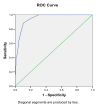The Child Behaviour Assessment Instrument: development and validation of a measure to screen for externalising child behavioural problems in community setting
- PMID: 20529304
- PMCID: PMC2897774
- DOI: 10.1186/1752-4458-4-13
The Child Behaviour Assessment Instrument: development and validation of a measure to screen for externalising child behavioural problems in community setting
Abstract
Background: In Sri Lanka, behavioural problems have grown to epidemic proportions accounting second highest category of mental health problems among children. Early identification of behavioural problems in children is an important pre-requisite of the implementation of interventions to prevent long term psychiatric outcomes. The objectives of the study were to develop and validate a screening instrument for use in the community setting to identify behavioural problems in children aged 4-6 years.
Methods: An initial 54 item questionnaire was developed following an extensive review of the literature. A three round Delphi process involving a panel of experts from six relevant fields was then undertaken to refine the nature and number of items and created the 15 item community screening instrument, Child Behaviour Assessment Instrument (CBAI). Validation study was conducted in the Medical Officer of Health area Kaduwela, Sri Lanka and a community sample of 332 children aged 4-6 years were recruited by two stage randomization process. The behaviour status of the participants was assessed by an interviewer using the CBAI and a clinical psychologist following clinical assessment concurrently. Criterion validity was appraised by assessing the sensitivity, specificity and predictive values at the optimum screen cut off value. Construct validity of the instrument was quantified by testing whether the data of validation study fits to a hypothetical model. Face and content validity of the CBAI were qualitatively assessed by a panel of experts. The reliability of the instrument was assessed by internal consistency analysis and test-retest methods in a 15% subset of the community sample.
Results: Using the Receiver Operating Characteristic analysis the CBAI score of >16 was identified as the cut off point that optimally differentiated children having behavioural problems, with a sensitivity of 0.88 (95% CI = 0.80-0.96) and specificity of 0.81 (95% CI = 0.75-0.87). The Cronbach's alpha exceeded Nunnaly's criterion of 0.7 for items related to inattention, aggression and impaired social interaction.
Conclusions: Preliminary data obtained from the study indicate that the Child Behaviour Assessment Instrument is a valid and reliable screening instrument for early identification of young children at risk of behavioural problems in the community setting.
Figures
Similar articles
-
Sinhala translation of the Perinatal Anxiety Screening Scale: a valid and reliable tool to detect anxiety disorders among antenatal women.BMC Psychiatry. 2020 Jul 21;20(1):381. doi: 10.1186/s12888-020-02757-z. BMC Psychiatry. 2020. PMID: 32693789 Free PMC article.
-
Sinhala translation of child behaviour checklist: validity and reliability.Ceylon Med J. 2008 Jun;53(2):40-4. doi: 10.4038/cmj.v53i2.230. Ceylon Med J. 2008. PMID: 18678120
-
Dutch norms for the Strengths and Difficulties Questionnaire (SDQ) - parent form for children aged 2-18 years.Health Qual Life Outcomes. 2018 Jun 14;16(1):123. doi: 10.1186/s12955-018-0948-1. Health Qual Life Outcomes. 2018. PMID: 29898729 Free PMC article.
-
[Psychometric characteristics of questionnaires designed to assess the knowledge, perceptions and practices of health care professionals with regards to alcoholic patients].Encephale. 2004 Sep-Oct;30(5):437-46. doi: 10.1016/s0013-7006(04)95458-9. Encephale. 2004. PMID: 15627048 Review. French.
-
[Diagnostic structured interviews in child and adolescent's psychiatry].Encephale. 2004 Mar-Apr;30(2):122-34. doi: 10.1016/s0013-7006(04)95422-x. Encephale. 2004. PMID: 15107714 Review. French.
Cited by
-
A systematic review of tools used to screen and assess for externalising behaviour symptoms in low and middle income settings.Glob Ment Health (Camb). 2019 Jul 15;6:e13. doi: 10.1017/gmh.2019.11. eCollection 2019. Glob Ment Health (Camb). 2019. PMID: 31391945 Free PMC article. Review.
-
Prevalence of externalizing behavior problems in Sri Lankan preschool children: birth, childhood, and sociodemographic risk factors.Soc Psychiatry Psychiatr Epidemiol. 2012 May;47(5):757-62. doi: 10.1007/s00127-011-0377-5. Epub 2011 Apr 8. Soc Psychiatry Psychiatr Epidemiol. 2012. PMID: 21476011
-
Video feedback for parental sensitivity and attachment security in children under five years.Cochrane Database Syst Rev. 2019 Nov 29;11(11):CD012348. doi: 10.1002/14651858.CD012348.pub2. Cochrane Database Syst Rev. 2019. PMID: 31782528 Free PMC article.
References
-
- World Health Organization. Caring for children and adolescents with mental disorders; Setting WHO directions. Geneva. 2003.
-
- Perera H, Perera R. User satisfaction in a child mental health service: implications for practice. Ceylon Medical Journal. 1998;44:185–190. - PubMed
LinkOut - more resources
Full Text Sources


